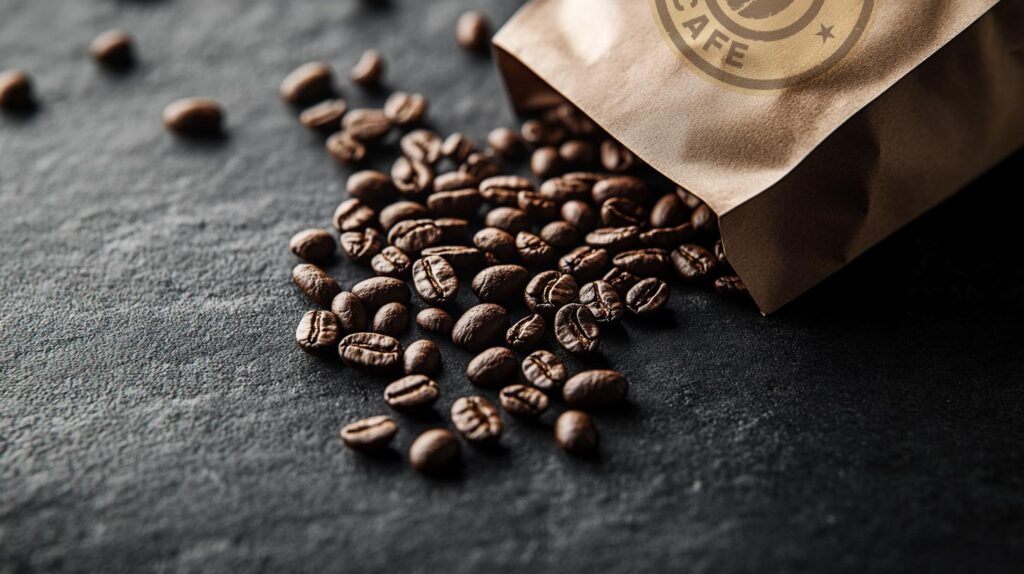
Forma y formato de las bolsas de café: mejorando la presentación y funcionalidad
La forma y el formato de las bolsas de café juegan un papel crucial tanto en la presentación del producto como en su usabilidad. Ya sea la clásica bolsa con base cuadrada o el diseño estilizado con sellado en cuatro lados, la forma debe adaptarse no solo al peso del café, sino también al material y a la estética de la marca. La elección del formato impacta directamente en el almacenamiento, la atracción en el estante y la conservación de la frescura. Elegir la forma adecuada puede influir directamente en cómo los clientes perciben la calidad y la conveniencia del empaque.
Formas comunes de bolsas de café y distribución del peso
- Bolsas con base plana (block-bottom):
Base firme que permite sostener pesos mayores, hasta 2 libras (aprox. 900 g). - Bolsas stand-up (con fuelle inferior):
Ligeras, ideales para cantidades pequeñas (hasta 12 oz / 340 g). - Bolsas con sellado en cuatro lados (quad-seal):
Estructura firme y rígida, soporta de 12 oz a 5 lb. - Bolsas con fuelle lateral (gusseted):
Expansibles, ideales para 1 a 3 lb de café. - Bolsas tipo almohada (pillow bags):
Económicas y simples, adecuadas para 6 a 10 oz.
Cuando se superan las 5 libras, muchas marcas migran a envases tipo canister, que brindan mayor soporte estructural y mejor protección.
Consideraciones de materiales según la forma
El material del empaque afecta directamente la forma, rigidez y durabilidad de la bolsa.
- Laminados plásticos y de aluminio: adecuados para bolsas stand-up y quad-seal por su resistencia y flexibilidad.
- Papel kraft: común en bolsas con base plana, ofrece una estética natural pero necesita refuerzos para pesos mayores.
- Películas metálicas o plásticos de alta barrera: ideales para formatos resistentes y almacenamiento prolongado.
Detalles por tipo de bolsa
Bolsas con base plana (block-bottom)
- Capacidad: 12 oz a 2 lb
- Estabilidad: Muy alta
- Cambio a canisters: Recomendado para más de 5 lb
Bolsas stand-up (con fuelle inferior)
- Capacidad: 6 a 12 oz
- Estabilidad: Ligera, limitada en pesos mayores
- Cambio a canisters: A partir de 1 lb
Bolsas con sellado en cuatro lados (quad-seal)
- Capacidad: 12 oz a 5 lb
- Estabilidad: Excelente
- Cambio a canisters: Sobre 5 lb
Bolsas con fuelle lateral (gusseted)
- Capacidad: 1 a 3 lb
- Estabilidad: Buena, aunque pierde forma si se sobrecarga
- Cambio a canisters: Desde 5 lb en adelante
Bolsas tipo almohada (pillow bags)
- Capacidad: 6 a 10 oz
- Estabilidad: Baja, no se mantienen en pie
- Cambio a canisters: Para más de 12 oz
Cambio a canisters: cuando las bolsas llegan a su límite
Al superar los 5 lb de contenido, muchas marcas cambian a canisters metálicos o de cartón reforzado. Estos ofrecen mayor estabilidad, protección contra el aire y humedad, y una mejor presentación para venta al por mayor. Además, son apilables y resistentes al manejo, ideales para mercados mayoristas o retail de gran volumen.
Impacto ecológico en la forma de las bolsas
La creciente demanda por empaques sostenibles influye en las formas y materiales disponibles.
- Materiales compostables y biodegradables se usan en bolsas stand-up y con base plana.
- Aunque pueden afectar la rigidez, los diseños innovadores permiten competir con los materiales tradicionales.
- La clave está en equilibrar durabilidad y sostenibilidad, ya que algunos materiales ecológicos aún no igualan la resistencia de los plásticos convencionales. Sin embargo, los avances tecnológicos están haciendo que estas opciones sean cada vez más viables.
¿Quieres que esto se prepare como una guía visual o tabla para web o impresión?
